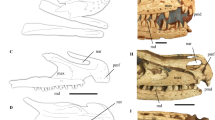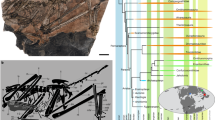Abstract
Therizinosauroidea (‘segnosaurs’) are little-known group of Asian dinosaurs with an unusual combination of features that, until recently, obscured their evolutionary relationships. Suggested affinities include Ornithischia1, Sauropodomorpha2,3, Theropoda4,5,6,7,8,9,10,11 and Saurischia sedis mutabilis12. Here we describe a new therizinosauroid from the Yixian Formation (Early Cretaceous, Liaoning, China)13. This new taxon provides fresh evidence that therizinosauroids are nested within the coelurosaurian theropods8,9,10,11. Our analysis suggests that several specialized therizinosauroid characters, such as the Sauropodomorpha-like tetradactyl pes1,2, evolved independently within this group. Most interestingly, this new dinosaur has integumentary filaments as in Sinosauropteryx14,15. This indicates that such feather-like structures may have a broad distribution among non-avian theropods, and supports the hypothesis that the filamentous integumentary structures may be homologous to the feathers of birds14,15.
This is a preview of subscription content, access via your institution
Access options
Subscribe to this journal
Receive 51 print issues and online access
$199.00 per year
only $3.90 per issue
Buy this article
- Purchase on Springer Link
- Instant access to full article PDF
Prices may be subject to local taxes which are calculated during checkout




Similar content being viewed by others
References
Paul, G. S. The segnosaurian dinosaurs: relics of the prosauropod-ornithischian transition. J. Vert. Paleontol. 4, 507–515 (1984).
Gauthier, J. A. Saurischian monophyly and the origin of birds. Mem. Calif. Acad. Sci. 8, 1–55 (1986).
Sereno, P. C. Prosauropod monophyly and basal sauropodomorph phylogeny. J. Vert. paleontol.(suppl.) 9, 38A (1989).
Perle, A. Segnosauridae—a new family of theropods from the Late Cretaceous of Mongolia. Trans. Joint Soviet–Mongolian Palaeontological Expedition 8, 45–55 (1979).
Perle, A. Anew segnosaurid from the Upper Cretaceous of Mongolia. Trans. Joint Soviet–Mongolian Palaeontological Expedition 15, 28–39 (1981).
Barsbold, R. & Perle, A. Segnosauria, a new infraorder of carnivorous dinosaurs. Acta Palaeontol. Pol. 25(2), 187–195 (1980).
Barsbold, R. Carnivorous dinosaurs from the Cretaceous of Mongolia. Trans. Joint Soviet–Mongolian Palaeontological Expedition 19, 1–116 (1983).
Russell, D. A. & Dong, Z. The affinities of a new theropod from the Alxa Desert, Inner Mongolia, China. Can. J. Earth Sci. 30, 2107–2127 (1993).
Clark, J. M., Perle, A. & Norell, M. A. The skull of Erlicosaurus andrewsi, a Late Cretaceous “Segnosaur” (Theropod: Therizinosauridae) from Mongolia. Am. Mus. Novit. 3115, 1–39 (1994).
Sues, H.-D. On Chirostenotes, a Late Cretaceous Oviraptorosaur (Dinosauria: Theropod) from Western North America. J. Vert. Paleontol. 17, 498–716 (1997).
Makovicky, P. & Sues, H.-D. Anatomy and phylogenetic relationships of the theropod dinosaur Microvenator celer from the Lower Cretaceous of Montana. Am. Mus. Novit. 3240, 1–27 (1998).
Barsbold, R. & Maryanska, T. in The Dinosauria (eds Weishampel, D. B., Dodson, P. & Osmolska, H.) 408–415 (Univ. California Press, Berkeley, (1990).
Swisher, C. C., Wang, Y.-q., Wang, X.-, Xu, X. & Wang, Y. 40Ar/39Ar dating of the lower Yixian Fm., Liaoning Province, northeastern China. Chinese Sci. Bull. (suppl.) 43, 125 (1998).
Ji, Q. & Ji, S. A. On discovery of the earliest bird fossil in China and the origin of birds. Chinese Geol. 233, 30–33 (1996).
Chen, P.-j., Dong, Z.-m. & Zhen, S.-A. An exceptionally well preserved theropod dinosaur from the Yixian Formation of China. Nature 391, 147–152 (1998).
Ji, Q., Currie, P. J., Norell, M. A. & Ji, S.-A. Two feathered dinosaurs from northeastern China. Nature 393, 753–761 (1998).
Martin, L. D. in Origins of Higher Groups of Tetrapods (eds Schultz, H.-P. & Treube, L.) 485–540 (Cornell Univ. Press, Ithaca, N. Y., (1991).
Bellairs, A. D'A. & Jenkin, C. R. in Biology and Comparative Physiology of Birds Vol. 9 (ed. Marshall, A.) 241–300 (Academic, New York, (1960).
Perle, A., Chiappe, L. M., Barsbold, R., Clark, J. M. & Norell, M. A. Skeletal morphology of Mononykus olecranus (Theropod, Avialae) from the Late Cretaceous of Mongolia. Am. Mus. Novit 3105, 1–29 (1994).
Ostrom, J. H. Osteology of Deinonychus antirrhopus, an unusual theropod from the Lower Cretaceous of Montana. Bull. Peabody Mus. Nat. Hist., Yale Univ. 30, 1–165 (1969).
Ji, Q. & Ji, S. A. Protarchaeopterygid bird (Protarchaeopteryx gen. nov.)-fossil remains of archaeopterygids from China. Chinese Geol. 238, 38–41 (1997).
Russell, D. A. in Encyclopedia of Dinosaurs (eds Currie, P. J. & Padian, K.) 729–730 (Academic, San Diego, (1997).
Norell, M. & Makovicky, P. J. Important features of the Dromaeosaur skeleton: information from a new specimen. Am. Mus. Novit. 3215, 1–28 (1997).
Chiappe, L., Norell, M. A. & Clark, J. Phylogenetic position of Mononykus (Aves: Alvarezauridae) from the Late Cretaceous of the Gobi Desert. Mem. Queensland Mus. 39, 557–582 (1996).
Zhao, X. & Xu, X. The oldest coelurosaurian. Nature 394, 234–235 (1998).
Unwin, D. M. Feathers, filaments and theropod dinosaurs. Nature 391, 119–120 (1998).
Gibbons, A. Plucking the feathered dinosaur. Science 278, 1229 (1997).
Acknowledgements
We thank J. Clark for advice and reviewing the manuscript; Z.-X. Luo for improving the organization and language of the manuscript as well as the use of PAUP 3.11; Z.-H. Zhou and O.Rauhut for discussions; P. Currie, M. Norell, P. Sereno, X.-C. Wu and H. Osmolska for reviews and comments; and the Liaoxi expedition members of the IVPP. Photographs were taken by J. Zhang, electronic photography by L. Oyang, and line drawings are by R.-S. Li, Y.-T. Li, H.-J. Wang and J.-Z. Ding prepared the specimen. This study was supported by research grants from the Chinese Academy of Sciences and the National Natural Science Foundation of China.
Author information
Authors and Affiliations
Corresponding author
Supplementary Information
Rights and permissions
About this article
Cite this article
Xu, X., Tang, Zl. & Wang, Xl. A therizinosauroid dinosaur with integumentary structures from China. Nature 399, 350–354 (1999). https://doi.org/10.1038/20670
Received:
Accepted:
Issue Date:
DOI: https://doi.org/10.1038/20670
This article is cited by
-
New therizinosaurid dinosaur from the marine Osoushinai Formation (Upper Cretaceous, Japan) provides insight for function and evolution of therizinosaur claws
Scientific Reports (2022)
-
Pterosaur melanosomes support signalling functions for early feathers
Nature (2022)
-
Study on the Jehol Biota: Recent advances and future prospects
Science China Earth Sciences (2020)
-
A new transitional therizinosaurian theropod from the Early Cretaceous Jehol Biota of China
Scientific Reports (2019)
-
A new caenagnathid dinosaur from the Upper Cretaceous Wangshi Group of Shandong, China, with comments on size variation among oviraptorosaurs
Scientific Reports (2018)
Comments
By submitting a comment you agree to abide by our Terms and Community Guidelines. If you find something abusive or that does not comply with our terms or guidelines please flag it as inappropriate.



